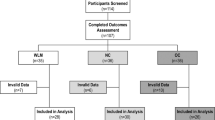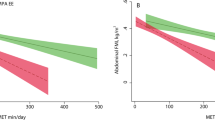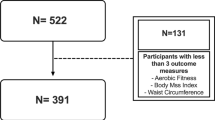Abstract
OBJECTIVE: The present study investigated whether making access to sedentary activities contingent on physical activity would increase physical activity.
DESIGN: Experimental.
PARTICIPANTS: Thirty-four obese children aged 8–12 y were randomized to one of three groups in which children had to accumulate 750 or 1500 pedometer counts to earn 10 min of access to video games or movies, or to a control group in which access to sedentary behaviors was provided noncontingently.
MEASUREMENTS: Physical activity in the 20 min experimental session was measured by electronic pedometer and triaxial accelerometer (ie TriTrac®). Activity liking was measured by visual analog scales. Anthropometric and demographic characteristics were also assessed.
RESULTS: Children in the 750 and 1500 count contingency groups engaged in significantly more physical activity and spent more time in moderate intensity activity or higher compared with controls. Children in the Contingent 1500 group engaged in more activity and spent more time in moderate or greater intensity activity compared to children in the Contingent 750 group.
CONCLUSION: Findings suggest that contingent access to sedentary activities can reinforce physical activity in obese children, and changes in physical activity level depend in part on the targeted physical activity goal.
This is a preview of subscription content, access via your institution
Access options
Subscribe to this journal
Receive 12 print issues and online access
$259.00 per year
only $21.58 per issue
Buy this article
- Purchase on Springer Link
- Instant access to full article PDF
Prices may be subject to local taxes which are calculated during checkout

Similar content being viewed by others
References
Andersen RE, Crespo CJ, Bartlett SJ, Cheskin LJ, Pratt M . Relationship of physical activity and television watching with body weight and level of fatness among children: results from the Third National Health and Nutrition Examination Survey JAMA 1998 279: 938–942.
Dietz WH, Gortmaker SL . Do we fatten our children at the television set? Obesity and television viewing in children and adolescents Pediatrics 1985 75: 807–812.
Epstein LH, Smith JA, Vara LS, Rodefer JS . Behavioral economic analysis of activity choice in obese children Health Psychol 1991 10: 311–316.
Epstein LH, Saelens BE, Myers MD, Vito D . Effects of decreasing sedentary behaviors on activity choice in obese children Health Psychol 1997 16: 107–113.
Epstein LH, Saelens BE, O'Brien JG . Effects of reinforcing increases in active behavior versus decreases in sedentary behavior for obese children Int J Behav Med 1995 2: 41–50.
Timberlake W, Farmer-Dougan VA . Reinforcement in applied settings: figuring out ahead of time what will work Psychol Bull 1991 110: 379–391.
Coleman KJ, Paluch R, Epstein LH . A method for delivering reinforcement during exercise Behav Res Meth Instruments Comput 1997 29: 286–290.
Saelens BE, Epstein LH . Behavioral engineering of activity choice in obese children Int J Obes Relat Metab Disord 1998 22: 275–277.
Faith MS, Berman N, Heo M, Pietrobelli A, Gallagher D, Epstein LH, Eiden MT, Allison DB . Effects of contingent-TV on physical activity and TV-viewing in obese children (submitted).
Dworkin BR . Learning and physiological regulation Univer-sity of Chicago Press: Chicago, Il 1993.
Bassett DR, Ainsworth BE, Leggett SR, Mathien CA, Main JA, Hunter DC et al. Accuracy of five electronic pedometers for measuring distance walked Med Sci Sports Exerc 1996 28: 1071–1077.
Kilanowski CK, Consalvi AR, Epstein LH . Validation of an electronic pedometer for measurement of physical activity in children Pediatr Exerc Sci 1999 11: 63–68.
Must A, Dallal GE, Dietz WH . Reference data for obesity: 85th and 95th percentiles of body mass index (wt/ht2) and triceps skinfold thickness Am J Clin Nutr 1991 53: 839–846.
Must A, Dallal GE, Dietz WH . Reference data for obesity: 85th and 95th percentiles of body mass index (wt/ht2)—a correction Am J Clin Nutr 1991 54: 773.
Hollingshead AB . Four factor index of social status Yale University Press: New Haven, CN 1975.
Eston RG, Rowlands AV, Ingledew DK . Validity of heart rate, pedometry, and accelerometry for predicting the energy cost of children's activities J Appl Physiol 1998 84: 362–371.
Rowlands AV, Eston RG, Ingledew DK . Relationship between activity levels, aerobic fitness, and body fat in 8- to 10-yr-old children J Appl Physiol 1999 86: 1428–1435.
Wilkinson L . SYSTAT 6.0 for Windows SPSS Inc.: Chicago, IL 1996.
Saelens BE, Epstein LH . The rate of sedentary activities determines the reinforcing value of physical activity Health Psychol 1999 18: 655–659.
Hayes SC, Ju W . The applied implications of rule-governed behavior In: O'Donohue W, ed. Learning and behavior therapy Allyn & Bacon: Needham Heights, MA 1998,pp 374–391.
Dishman RK . Increasing and maintaining exercise and physical activity Behav Ther 1991 22: 345–378.
Epstein LH, Saelens BE . Behavioral economies of obesity: food intake and energy expenditure. InBickel WK, Vuchinich RE, eds. Reframing health behavior change with behavioral economics Lawrence Erlbaum: Mahwah, NJ, 2000, 293–312.
Acknowledgements
This research was supported in part by grant no. R01 HD 38284 and grant no. R01 HD 25997 awarded to Dr Epstein.
Author information
Authors and Affiliations
Rights and permissions
About this article
Cite this article
Goldfield, G., Kalakanis, L., Ernst, M. et al. Open-loop feedback to increase physical activity in obese children. Int J Obes 24, 888–892 (2000). https://doi.org/10.1038/sj.ijo.0801248
Received:
Revised:
Accepted:
Published:
Issue Date:
DOI: https://doi.org/10.1038/sj.ijo.0801248
Keywords
This article is cited by
-
Making access to TV contingent on physical activity: effects on liking and relative reinforcing value of TV and physical activity in overweight and obese children
Journal of Behavioral Medicine (2012)
-
Increasing children's physical activity: a peer modelling, rewards and pedometer-based intervention
European Journal of Clinical Nutrition (2009)
-
Correlates of Adherence to a Physical Activity Program in Young African‐American Girls
Obesity (2007)
-
Choice of interactive dance and bicycle games in overweight and nonoverweight youth
Annals of Behavioral Medicine (2007)



